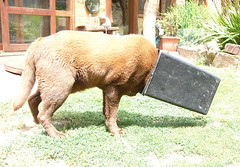 |
| Section of pancreas of dog. X 250. (Photo credit: Wikipedia) |
The title of this post sounds like the setup for a punchline, but it's no such thing: it's actually in clinical studies right now, spurred by a father's need to help his Type 1 son. You can read the story on TheDiabetesSite, where there is a petition going to get the FDA to move it up to the top of their review list once it is sent to them. Their goal is 10,000 signatures, and as of right now (12/28/13) they have 4,127. This petition has implications for everyone (humans and animals) with diabetes, since the more pressure that is put on the FDA for expediting new diabetes treatments each time, the better for all of us.
As it stands now, the bionic pancreas is a type 1 treatment and would not be practical for animals, but, as with any new idea, there is no way of knowing where it might lead others in their research and development efforts. I urge you to sign the petition.
TheDiabetesSite.com is part of the Greater Good Network, where users click on a box to help various causes for free. I've had a link to TheAnimalRescueSite.com since I began this blog, and I like to think that I've drawn some people to make clicking part of their daily activities.
And, today there's a bumper crop of related articles for you.











